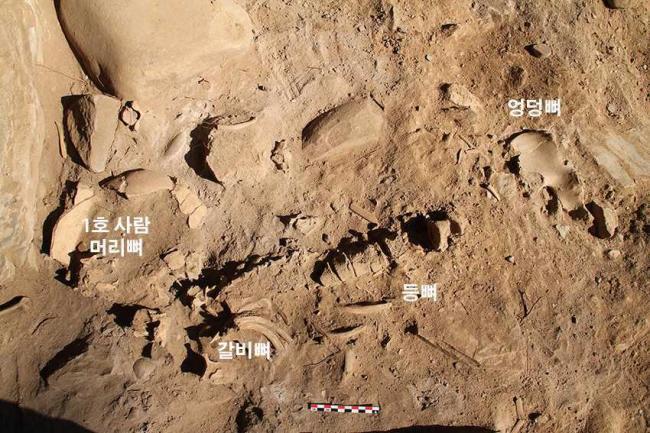3,000-year-old grave shows ancient people used fire during burial
By Yoon Min-sikPublished : May 23, 2017 - 16:23
South Korean researchers have found remnants of an ancient cave formed around 10th century BC, which suggest Bronze Age people conducted a ritual with fire before burying their dead.
Scientists from Yonsei University Museum uncovered a burial site in an ancient cave in Jeongseon-gun, Gangwon Province, where they found bones of at least four people along with relics.
The excavation was conducted under the authority of the Cultural Heritage Administration.
Scientists from Yonsei University Museum uncovered a burial site in an ancient cave in Jeongseon-gun, Gangwon Province, where they found bones of at least four people along with relics.
The excavation was conducted under the authority of the Cultural Heritage Administration.

Carbon dating showed that the layer of ash the bones were found in had been created around eighth to 12th century BC, which indicates that the human remains were from the Bronze Age. The ash layer below had a mixture of relics from both the Bronze Age and Neolithic era.
The museum’s Director Han Chang-gyun explained that the thick layer of ash suggests that ancient people had used fire during their burial rituals.
“This is the first time that evidence of a fire ritual has been found in burial caves of the Bronze Age. It will offer us clues into studies of such rituals,” Han said.
He said that the stone arrowheads found in the cave are similar to a dolmen -- a type of single-chamber megalithic tomb -- found near the cave and they may be related to the burial ritual.
An additional study on the human bones will take place to determine the deceased’s sex, age, and relationship with one another. Yonsei University Museum is slated to resume its dig next month.
By Yoon Min-sik
(minsikyoon@heraldcorp.com)






![[From the Scene] Monks, Buddhists hail return of remains of Buddhas](http://res.heraldm.com/phpwas/restmb_idxmake.php?idx=644&simg=/content/image/2024/04/19/20240419050617_0.jpg&u=20240419175937)





![[Graphic News] French bulldog most popular breed in US, Maltese most popular in Korea](http://res.heraldm.com/phpwas/restmb_idxmake.php?idx=644&simg=/content/image/2024/04/18/20240418050864_0.gif&u=)



![[From the Scene] Monks, Buddhists hail return of remains of Buddhas](http://res.heraldm.com/phpwas/restmb_idxmake.php?idx=652&simg=/content/image/2024/04/19/20240419050617_0.jpg&u=20240419175937)

![[KH Explains] Hyundai's full hybrid edge to pay off amid slow transition to pure EVs](http://res.heraldm.com/phpwas/restmb_idxmake.php?idx=652&simg=/content/image/2024/04/18/20240418050645_0.jpg&u=20240419100350)

![[Today’s K-pop] Illit drops debut single remix](http://res.heraldm.com/phpwas/restmb_idxmake.php?idx=642&simg=/content/image/2024/04/19/20240419050612_0.jpg&u=)